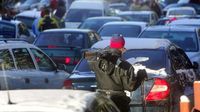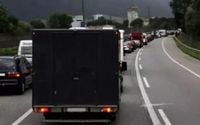In a significant move aimed at improving traffic flow and reducing congestion, the Romanian Senate is currently discussing a draft law to implement the "zipper rule" within the Traffic Code. This proposed regulation would require drivers on an adjacent lane to allow vehicles from a blocked lane to merge in an alternating manner, a practice already successful in several European countries.
The "zipper rule" comes into play in situations where one lane is obstructed—either due to construction, road narrowing, or parked vehicles. According to the draft law, when traffic on one lane becomes blocked, drivers on the adjacent lane will be mandated to let vehicles from the affected lane enter their lane in turns. This approach is expected to facilitate smoother traffic flow and minimize conflicts among drivers.
As stated in the proposal, "when traffic on one of the lanes of a multi-lane road is blocked due to an obstacle, lane narrowing, or other reasons, drivers on the adjacent lane are obliged to allow vehicles from the affected lane to merge onto the adjacent lane alternately." By implementing this rule, lawmakers believe that traffic congestion can be alleviated, particularly in urban areas where bottlenecks are common.
The initiative to formalize the "zipper rule" is driven by the need for clearer regulations regarding driver behavior, especially in situations where lanes converge. If adopted, non-compliance with the rule would be categorized as a minor offense, with fines set at approximately 600 lei. This fine is classified as a Class I sanction, which is generally considered less severe, aimed at encouraging compliance without imposing overly harsh penalties.
Experts emphasize that the successful adoption of the rule hinges on effective public education. Authorities will need to launch awareness campaigns to inform drivers about the new regulations and the benefits of adhering to them. This educational approach is seen as essential for fostering a culture of cooperation among drivers, thereby enhancing overall road safety.
Countries like Germany, Austria, Switzerland, and the Netherlands have already seen positive outcomes from the implementation of similar traffic rules. The Romanian draft law draws inspiration from these nations, which have successfully integrated the "zipper rule" into their driving practices. The Romanian lawmakers hope that by following this model, the country can move closer to European traffic standards.
To become law, the draft legislation must first pass through the Senate, then proceed to the Chamber of Deputies for final approval. Following this, it will be sent to the President of Romania for promulgation. Only after its publication in the Official Gazette will the rule take effect, marking a significant step toward modernizing Romania's traffic regulations.
In conclusion, the introduction of the "zipper rule" represents a progressive shift in Romanian traffic law, aiming to enhance the driving experience and promote safer road conditions. If successful, this law could pave the way for a more civilized and efficient approach to driving in Romania, aligning the country with established practices seen in other European nations.





